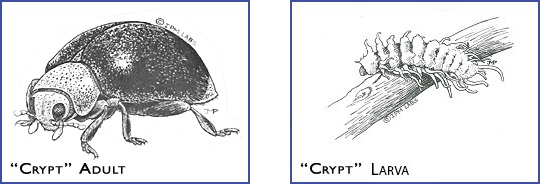Interior Landscapes – Scale and Mealybugs
Scale Controls
Armored scale parasite: Aphytis melinus
This tiny yellow wasp lays its eggs under the covering of mid-sized scales. Larvae develop over 2-3 weeks, pupate, and emerge as adults by cutting a hole in the outer covering of the scale.
Target pests: Oleander, California Red, Yellow, & Dictyospermum scales
Scale Predator: Lindorus lophanthae or Rhyzobius lophanthae
Singular lady beetle or ‘scale destroyer’.
A small beetle with a black wing covers and burnt-orange head, thorax and abdomen. Adult females lay hundreds of eggs under scales that hatch as alligator-shaped larvae that feed on scale eggs and crawlers for about two weeks before pupating. Adults feed on all stages of scales and are quite voracious.
Target pests: California Red, Purple, and other armored and soft scales
Optimal environment: 75-80° F (OK down to 40°F)
Mealybug Controls
Predator: Cryptolaemus montrouzieri
(‘Crypts’ for short, also, the ‘mealybug destroyer’)
These tropical lady beetles exert rapid control over high populations of citrus mealybugs. They do not do well when the mealybug population is sparse. Both adult and larval crypts actively prey on mealybugs. Adult crypts are about 1/6 inch long, and black with orange heads and “tails”. Crypt larvae are covered with white waxy filaments, which makes them look similar to mealybugs. Adults lay 200-700 eggs during their 27-70 day lifespan. Development from egg to adult is nearly twice as fast at 80°F as it is at 70°F. Crypts are inactive at temperatures below 60°F, slow at 70° but stop searching when the temperature is above 90°F.
Optimal Environment: 75-80°F, 60% RH
Application Rate: 2-5 per infested plant or 2-5 per 10 square feet. 20-100 per tree.
Predator: Lacewing larvae These voracious young of the familiar lacewing insect are known as aphid lions, but they also feed on mealybugs, scales, spider mites, and other pests. Lacewings are shipped as eggs or larvae. After hatching, the larvae remain active for 10-14 days. Mature larvae pupate and later emerge as adults, which typically disperse before laying eggs for future generations of larvae.
Optimal Environment: 60-80°F
Application Rate:
| Lacewing eggs on card, 30 strips/card |
5,000 eggs |
0.5 strip per pot (1-6 sq ft) biweekly |
| Lacewing eggs, loose |
1,000 | Minimum order, 5000, 8 to 20+ eggs per square foot, biweekly |
| Lacewing larvae, bottle or frame |
1,000 larvae |
10 per square foot of infested area, biweekly |
IPM Laboratories, Inc. warrants that the biological controls you receive will be alive and healthy when received and will contain the correct number of the species you ordered. However, as with any pest control measure, success cannot be guaranteed. IPM Laboratories, Inc. makes no guarantee, express or implied, as to the effectiveness of these products.
All images are copyrighted to IPM Laboratories, Inc. and may not be copied or reproduced without permission.

